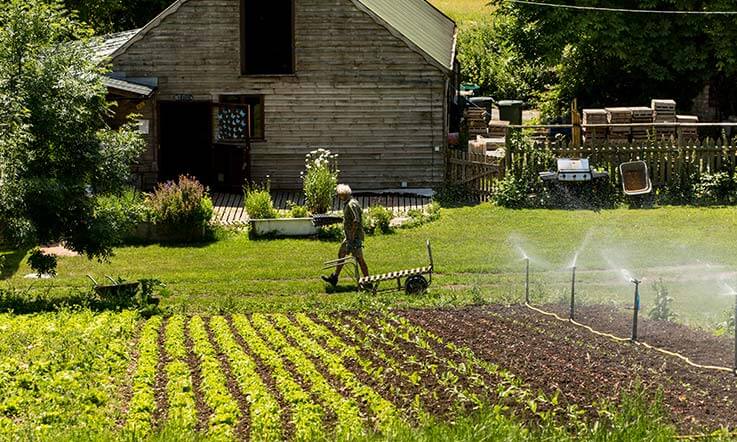Blog by Marianne Landzettel
Loving soil wasn’t just this year’s Groundswell slogan, it was the topic, in depth and from the ground up, in practice and in theory, in detail, from a global and from a bird’s eye perspective.
Several well-known speakers, in particular those from the US, made the case for the interdependence of ruminants, in particular beef cattle, permanent pasture, carbon sequestration and water retention. Farmers and ranchers could be ‘climate heroes’ if they used cattle as land managers, said Seth Itzkhan, cofounder of the international nongovernmental organisation Soil4Climate. Holistic managed grazing, a practice that makes sure pastures are neither over nor undergrazed, was pioneered by Allan Savory. Itzkhan showed impressive images taken on one day: the first set from Victoria Falls National Park in north-western Zimbabwe where cattle grazing is not allowed and much of the bare soil shows deep cracks. Just 20km to the south, Allan Savory has used cattle and mob grazing to re-establish savannah grasses, and since the soil has improved the creeks carry water once again. To Itzkhan, water rather than soil will be the measurable of eco benefits: the water infiltration rate and water holding capacity of soil are easy to see, as the soil scientist Jill Clapperton demonstrated by emptying a watering can on three soil samples: while soil with plenty of soil life, mycorrhizal fungi and living roots absorbs and holds water, the water quickly starts to run off soil that lacks ‘good tilth’ (for example because it has been tilled), washing away nutrients and soil particles.
Greg Judy, rancher, author and educator, runs an organic farm in the US state of Missouri and gave a very practical introduction into how an operation such as Green Pastures Farm can be both profitable and environmentally beneficial. First and foremost, “we are microbe farmers,” he says, “we need to provide food, shelter and moisture and otherwise leave them alone, which means no ploughing.” His herd of 400 beef cattle is moved frequently so that one third of the grass is grazed, one third trampled and one third left standing, providing and excellent habitat for birds and insects. “There is only one thing that can heal the planet and that is ruminant animals,” says Judy. Some of the farm’s land is forested, ideal for cattle during the hot summer month. Judy now uses some of the logged trees to grow shitake mushrooms which he says is very profitable. Through his books and Youtube channel he and his wife are quite well known by now, but they still have to work on building their brand and use every business opportunity: they direct-market the meat, sell breeding stock and semen, raise pigs, run a flock of 350 sheep, produce fence posts, sell lumber and have a cabin for holiday lets.
What about arable farms? Plant scientist Dwayne L. Beck is the research manager at a university farm in South Dakota and an adamant ‘no-tiller’. “For soil life, tillage is a catastrophic event”, he says. He’d rather use glyphosate to kill weeds and cover crops than plough. In the discussion after the event organic farmers made the case for ploughing occasionally but never ever using herbicides. Beck does not accept that with different soil types and weather conditions – South Dakota is extremely dry and irrigation often an absolute necessity – an organic min-till system could have merit. But despite the no-till vs no herbicide controversy, the debate also made clear how much agreement there is between regenerative and organic farmers: looking after the soil is key, as are increasing biodiversity, keeping livestock, working with long rotations and having living roots in the soil year-round.
Among the 5,000 or so farmers visiting Groundswell there were those who wanted to exchange views on which practices worked and which ones didn’t, others were interested in innovations – from new tools to measure soil carbon to direct drilling equipment – and some engaged for the first time with a type of farming that puts so much emphasis on soil health. Brexit, the end of the BPS and the introduction of ELMs may contribute to changing attitudes such as reducing inputs, increasing biodiversity and prioritising soil health over yields. From talks and presentations to practical demonstrations and Q &A sessions – Groundswell made it easy for farmers to take a deep dive or just dip their toe into something new. And soil health seems to be a goal everyone can agree on. What matters less is whether farmers get there via the regenerative or the organic farming route – both lead in the right direction.
Browse all Groundswell videos https://youtube.com/playlist?list=PL5ZXKRVhhiD0vDD3OCUAL3CpP_UA07atu
